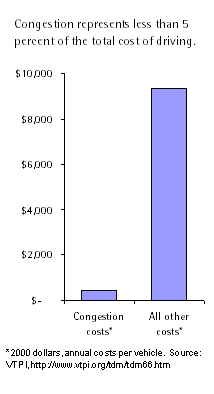The ever-geekalicious Todd Litman of the Victoria Transport Policy Institute had a great take on traffic congestion a few weeks back on Planetizen.
As Litman explains, most congestion studies (such as this annual study, which always gets a lot of press) consistently overestimate the costs of congestion. But even using these relatively high estimates, the costs of congestion are pretty modest, compared with the comprehensive costs of owning and operating a car.

Of course, some congestion “solutions” actually increase other costs of driving. Building lanes, for example, is costly in itself. Plus, more lanes means more total traffic on the region’s roads, which can simultaneously a) increase congestion elsewhere in the road system, b) increase overall parking costs, c) increase crash and pollution costs. Taking all costs into account, “curing” congestion by expanding capacity can be more expensive than the disease itself. And as the graph shows, you don’t have to increase the other costs by much, in percentage terms, before the extra costs overwhelm the modest, temporary benefits of congestion relief.









Jeff
For Washington State, by including road building and road maintenance and also gasoline, Litman is including the same dollars twice. The state and federal gas taxes on each gallon pay for construction and maintenance of ALL the state highways, the ferry system, and provides almost all the funding for local and county road construction and maintenance. As opposed to other states, Washington doesn’t use general fund revenues to pay for any of the transportation budget. The graph would still make its point at half the size, but one wonders how he came up with the rest of the figures he used? On top of that, recognize the Texas congestion report uses both time and dollars as measures – time for drivers, dollars for legislators and bureaucrats. It provides a way to evaluate a proposed congestion reduction highway project – what it will cost versus what it will save.
Dan
Jeff,drivers don’t limit their driving to state roads. Local roads usu come out of local funds – general funds, impact fees, taxation (which usu goes to general fund). And I agree with you that the cost of congestion comes to the individual in time.
Morgan Ahouse
Todd rocks. I wish I still had the time to read as many of his reports as I used to.A take away for me is that traffic demand may be more sensitive to marginal cost than I used to think. Or, at least it is when cost is measured in time rather than in dollars. I also like Todd’s point that pricing is efficient when it allows users to pursue transpo choices according to value and cost, which in turn guides the macro economy toward greater efficiency. Kinda Smithian and probably not applicable to short term decisions for many consumers, but I still fancy it. On the other hand, I do have progressivity concerns when the financially wealthy are allowed to outbid those less financially wealthy.
Clark Williams-Derry
I agree—Todd rocks, and pricing raises my equity hackles too. At a minimum, I’d want congestion pricing revenue used to improve transportation services for people who are priced out of their cars. One odd thought—and I don’t know if other people have thought about this—is that congestion pricing might affect where the well-off tend to live. Without congestion pricing, central-city living becomes particularly attractive for high-income folks, since their time is so valuable. (Being delayed by congestion can mean a real economic hit—so some high-income folks choose condos close to downtown.) With congestion pricing, high-income folks can trade some money (which they’ve got plenty of) for time. They may choose homes farther from the center, knowing that they can always buy their way to a fast commute.I’m not sure what the end result would be. But you might see a bit of pressure taken off housing and land prices downtown: which could mean more opportunities for other economic groups to live close to where they work.This is all just speculation though. Anybody have any thoughts?
david
Congestion pricing affecting real estate values is an interesting topic. I think the key is how much congestion would congestion pricing fix ? Does anyone know? If only the rich could afford to use highways in addition to parking downtown, plus daily gas money, would our congestion problems simply vanish? If the common workers of the world could no longer get to work in their cars and had no other transportation alternatives other than 2 or 3 bus transfers into town and simply gave up and got work near their homes, it could be a real problem for companies to find blue collar workers in the downtown area.Forget real estate values for a second, will companies be able to staff blue collar positions? Would a shortage be created? would that shortage drive blue collar wages up perhaps where they should be anyway? Would they then be able to afford a downtown condo?